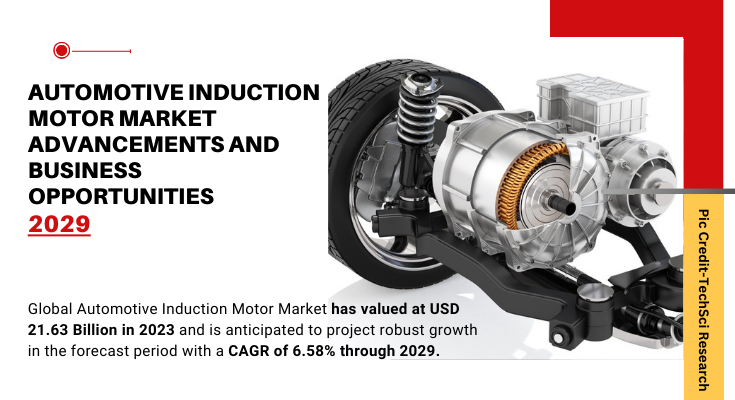According to TechSci Research report, “Global Automotive Induction Motor Market – Industry Size, Share, Trends, Competition Forecast & Opportunities, 2029”, the Global Automotive Induction Motor Market stood at USD 21.63 Billion in 2023 and is anticipated to grow with a CAGR of 6.58% in the forecast period, 2025-2029. The global automotive induction motor market is experiencing remarkable growth, primarily propelled by the surging adoption of electric vehicles worldwide. As the demand for fuel-efficient vehicles continues to rise, driven by the urgent need to reduce carbon footprints, automobile manufacturers are increasingly shifting towards sustainable solutions. This shift is not only driven by environmental concerns but also by regulatory policies and incentives that encourage the development and adoption of electric vehicles. Furthermore, advancements in technology and infrastructure are supporting the growth of the market, making electric vehicles more accessible and convenient for consumers. With the increasing focus on sustainability and the ongoing efforts to transition towards a greener future, the automotive induction motor market is expected to witness continued growth in the coming years.
Induction motors, also known as asynchronous motors, utilize the principle of electromagnetic induction to generate the rotating motion. By creating a rotating magnetic field, these motors enable the conversion of electrical energy into mechanical energy. According to recent market studies, Asia Pacific region leads the global automotive induction motor market, largely due to the swift growth of automotive industries in countries like China and India. The region is followed by Europe and North America, which are also showing a remarkable increase in the demand for induction motors, driven by strict government regulations on vehicle emissions.
Their higher efficiency, durability, and lower operational costs compared to conventional combustion engines make them an ideal choice for electric and hybrid electric vehicles. With their ability to deliver reliable and consistent performance, induction motors contribute to the advancement of sustainable transportation solutions, reducing emissions and promoting a greener future.
Furthermore, with the continuous advancements in motor technologies, the market growth is set to soar. The development of high-efficiency induction motors and the introduction of smart motor management systems are anticipated to be key drivers in this growth. Motor manufacturers have been actively investing in research and development activities to create compact yet highly efficient motors. These motors are not only capable of delivering exceptional performance but are also designed to be energy-efficient, addressing the growing need for sustainability in the industry. This focus on innovation and efficiency is shaping the landscape of motor technology, paving the way for a future of high-performance and environmentally-friendly solutions.
However, the market growth of electric and hybrid vehicles may be restrained by several factors. One of the main challenges is the high initial cost of induction motors, which can deter potential buyers. Additionally, the lack of charging infrastructure in many regions poses a significant hurdle to widespread adoption. To overcome these obstacles, it is crucial to create awareness among consumers about the numerous benefits that electric and hybrid vehicles offer, such as reduced emissions and long-term cost savings. By addressing these concerns and promoting the advantages of this sustainable technology, we can accelerate the growth of the market and transition towards a greener future.
The competition in the global automotive induction motor market is intense, with several key players such as Tesla, Bosch, Denso, and General Motors. These companies are not only investing heavily in research and development but also forming strategic collaborations with other firms to maintain a competitive edge in the market.
In conclusion, the automotive induction motor market is poised for substantial growth in the coming years. With the increasing production of electric vehicles, mounting environmental concerns, rapid technological advancements, and favorable government policies, the market is expected to experience a significant boost. The transition towards electric mobility and the adoption of sustainable transportation solutions are driving factors behind this projected growth.
Browse over market data Figures spread through 180 Pages and an in-depth TOC on the “Global Automotive Induction Motor Market” @ https://www.techsciresearch.com/report/automotive-induction-motor-market/21862.html
The Automotive Induction Motor Market is witnessing a transformative phase as the automotive industry makes a significant shift toward electric mobility. Induction motors, known for their robustness, reliability, and simplicity, have become integral components in electric vehicles (EVs) and hybrid electric vehicles (HEVs). As the global automotive landscape evolves to address environmental concerns and stringent emission regulations, the adoption of induction motors represents a key trend that aligns with the industry’s commitment to sustainable transportation.
One of the primary drivers propelling the Automotive Induction Motor Market is the increasing global emphasis on reducing carbon emissions and dependence on traditional internal combustion engines. Governments worldwide are implementing stringent emission standards, encouraging automakers to explore alternative powertrain technologies. Induction motors offer a compelling solution as they operate without the need for rare-earth magnets, addressing concerns about the environmental impact of magnet production. This feature positions induction motors as environmentally friendly alternatives, contributing to the overall sustainability of electric propulsion systems.
The rise of electric vehicles is a significant trend shaping the Automotive Induction Motor Market. As consumers and manufacturers alike recognize the need for cleaner and more energy-efficient transportation, electric vehicles are gaining traction. Induction motors are widely employed in electric powertrains due to their simplicity and durability. Compared to other motor types, such as permanent magnet synchronous motors, induction motors are cost-effective and easier to manufacture. This makes them attractive for automakers aiming to produce affordable electric vehicles that can compete with traditional internal combustion engine vehicles on pricing.
In the pursuit of greater energy efficiency, induction motors play a vital role in the automotive industry’s efforts to optimize electric powertrains. With advancements in motor control technologies and power electronics, induction motors can be efficiently controlled and operated over a wide range of speeds. This flexibility is crucial for achieving high efficiency across diverse driving conditions, contributing to extended electric vehicle range and improved overall performance.
The Automotive Induction Motor Market also benefits from the inherent durability and reliability of induction motors. These motors have fewer moving parts compared to some alternative motor technologies, reducing the likelihood of mechanical failures and maintenance requirements. The simplicity of design and construction contributes to the overall longevity of induction motors, aligning with the automotive industry’s goals of producing vehicles with extended lifespans and lower total cost of ownership.
As automakers explore various electrification strategies, including hybridization, induction motors find applications in hybrid electric vehicles. The combination of an internal combustion engine and an electric motor in hybrid vehicles allows for enhanced fuel efficiency and reduced emissions. Induction motors serve as effective components in hybrid powertrains, providing electric propulsion during low-speed and urban driving while seamlessly integrating with the internal combustion engine for highway cruising.
The Automotive Induction Motor Market is witnessing technological advancements that further enhance the performance and efficiency of induction motors. Research and development efforts are focused on optimizing motor design, materials, and manufacturing processes to achieve higher power density and efficiency. Innovations in insulation materials, cooling systems, and control algorithms contribute to minimizing energy losses and maximizing the overall efficiency of induction motors in electric vehicles.
Challenges within the Automotive Induction Motor Market include addressing concerns related to power density and weight. While induction motors offer durability and simplicity, optimizing their power density becomes crucial for achieving compact and lightweight electric powertrains. This is particularly important in the context of electric vehicles, where reducing weight is paramount for extending range and improving overall efficiency. Ongoing research and engineering innovations are directed toward overcoming these challenges and enhancing the power-to-weight ratio of induction motors.
Market dynamics also involve considerations of cost competitiveness. While induction motors are generally more cost-effective to produce than some alternative motor technologies, achieving optimal cost efficiency remains a focus for manufacturers. Balancing performance, reliability, and cost is essential for ensuring that induction motors remain competitive in the growing market for electric vehicles, especially as consumer expectations rise, and the industry strives to make electric vehicles more accessible to a broader market.
The Automotive Induction Motor Market is witnessing a geographical expansion as various regions invest in electric vehicle infrastructure and promote the adoption of electric mobility. Government incentives, subsidies, and regulations supporting the transition to electric vehicles contribute to the market’s growth. Additionally, collaborations between automotive manufacturers and technology suppliers are fostering innovation and driving the widespread adoption of induction motors in electric vehicles.
In conclusion, the Automotive Induction Motor Market is undergoing a significant transformation as the automotive industry embraces electric mobility. Induction motors, with their simplicity, reliability, and cost-effectiveness, are playing a pivotal role in shaping the future of electric vehicles and hybrid electric vehicles. The market is characterized by ongoing advancements in motor technology, a focus on sustainability, and efforts to address challenges related to power density and cost competitiveness. As the global automotive landscape continues to evolve, the Automotive Induction Motor Market is positioned as a key enabler of electric propulsion systems, contributing to a more sustainable and efficient future for the automotive industry.
Major companies operating in the Global Automotive Induction Motor Market are:
- Rockwell Automation Inc.
- Nidec Motor Corporation
- ABB Ltd
- Siemens AG
- WEG Electric Corp.
- Regal Beloit Corporation
- Baldor Electric Company
- Emerson Electric Co.
- Schneider Electric SE
- Marathon Electric
To Download FREE Sample Pages of this Report📥 @ https://www.techsciresearch.com/sample-report.aspx?cid=21862
Customers can also request for 10% free customization on this report.
“The Global Automotive Induction Motor Market is at the forefront of the electric mobility revolution, witnessing a surge in demand as the automotive industry transitions toward sustainable transportation. Induction motors, known for their reliability and cost-effectiveness, play a pivotal role in powering electric vehicles and hybrid electric vehicles. With a focus on reducing carbon emissions and achieving greater energy efficiency, the market embraces advancements in motor technology, contributing to the overall growth of electric propulsion systems. As governments worldwide implement stringent emission standards, the Automotive Induction Motor Market stands as a key driver in reshaping the automotive landscape, fostering innovation, and propelling the industry toward a greener future.” said Mr. Karan Chechi, Research Director with TechSci Research, a research-based management consulting firm.
“Automotive Induction Motor Market – Global Industry Size, Share, Trends, Opportunity, and Forecast, Segmented By Type (Single-Phase Induction Motor and Three-Phase Induction Motor), By Sales Channel (OEM, Aftermarket), By Region, Competition, 2019-2029”, has evaluated the future growth potential of Global Automotive Induction Motor Market and provides statistics & information on market size, structure, and future market growth. The report intends to provide cutting-edge market intelligence and help decision-makers make sound investment decisions. Besides, the report also identifies and analyzes the emerging trends along with essential drivers, challenges, and opportunities in the Global Automotive Induction Motor Market.
You may also read:
Automotive Sealant Market – A Comprehensive Report [2029]
Automotive Transmission Engineering Services Outsourcing Market Worth [2029], Overview, Trends, Forecast
Laser Headlight Market | [Latest] Exploring Market Growth, Potential, Trends
Table of Content-Automotive Induction Motor Market
- Introduction
1.1. Product Overview
1.2. Key Highlights of the Report
1.3. Market Coverage
1.4. Market Segments Covered
1.5. Research Tenure Considered
- Research Methodology
2.1. Objective of the Study
2.2. Baseline Methodology
2.3. Key Industry Partners
2.4. Major Association and Secondary Sources
2.5. Forecasting Methodology
2.6. Data Triangulation & Validation
2.7. Assumptions and Limitations
- Executive Summary
3.1. Market Overview
3.2. Market Forecast
3.3. Key Regions
3.4. Key Segments
- Impact of COVID-19 on Global Automotive Induction Motor Market
- Global Automotive Induction Motor Market Outlook
5.1. Market Size & Forecast
5.1.1. By Value
5.2. Market Share & Forecast
5.2.1. By Type Market Share Analysis (Single-Phase Induction Motor and Three-Phase Induction Motor)
5.2.2. By Sales Channel Market Share Analysis (OEM, Aftermarket)
5.2.3. By Regional Market Share Analysis
5.2.3.1. Asia-Pacific Market Share Analysis
5.2.3.2. Europe & CIS Market Share Analysis
5.2.3.3. North America Market Share Analysis
5.2.3.4. South America Market Share Analysis
5.2.3.5. Middle East & Africa Market Share Analysis
5.2.4. By Company Market Share Analysis (Top 5 Companies, Others – By Value, 2023)
5.3. Global Automotive Induction Motor Market Mapping & Opportunity Assessment
5.3.1. By Type Market Mapping & Opportunity Assessment
5.3.2. By Sales Channel Market Mapping & Opportunity Assessment
5.3.3. By Regional Market Mapping & Opportunity Assessment
- Asia-Pacific Automotive Induction Motor Market Outlook
6.1. Market Size & Forecast
6.1.1. By Value
6.2. Market Share & Forecast
6.2.1. By Type Market Share Analysis
6.2.2. By Sales Channel Market Share Analysis
6.2.3. By Country Market Share Analysis
6.2.3.1. China Market Share Analysis
6.2.3.2. India Market Share Analysis
6.2.3.3. Japan Market Share Analysis
6.2.3.4. Indonesia Market Share Analysis
6.2.3.5. Thailand Market Share Analysis
6.2.3.6. South Korea Market Share Analysis
6.2.3.7. Australia Market Share Analysis
6.2.3.8. Rest of Asia-Pacific Market Share Analysis
6.3. Asia-Pacific: Country Analysis
6.3.1. China Automotive Induction Motor Market Outlook
6.3.1.1. Market Size & Forecast
6.3.1.1.1. By Value
6.3.1.2. Market Share & Forecast
6.3.1.2.1. By Type Market Share Analysis
6.3.1.2.2. By Sales Channel Market Share Analysis
6.3.2. India Automotive Induction Motor Market Outlook
6.3.2.1. Market Size & Forecast
6.3.2.1.1. By Value
6.3.2.2. Market Share & Forecast
6.3.2.2.1. By Type Market Share Analysis
6.3.2.2.2. By Sales Channel Market Share Analysis
6.3.3. Japan Automotive Induction Motor Market Outlook
6.3.3.1. Market Size & Forecast
6.3.3.1.1. By Value
6.3.3.2. Market Share & Forecast
6.3.3.2.1. By Type Market Share Analysis
6.3.3.2.2. By Sales Channel Market Share Analysis
6.3.4. Indonesia Automotive Induction Motor Market Outlook
6.3.4.1. Market Size & Forecast
6.3.4.1.1. By Value
6.3.4.2. Market Share & Forecast
6.3.4.2.1. By Type Market Share Analysis
6.3.4.2.2. By Sales Channel Market Share Analysis
6.3.5. Thailand Automotive Induction Motor Market Outlook
6.3.5.1. Market Size & Forecast
6.3.5.1.1. By Value
6.3.5.2. Market Share & Forecast
6.3.5.2.1. By Type Market Share Analysis
6.3.5.2.2. By Sales Channel Market Share Analysis
6.3.6. South Korea Automotive Induction Motor Market Outlook
6.3.6.1. Market Size & Forecast
6.3.6.1.1. By Value
6.3.6.2. Market Share & Forecast
6.3.6.2.1. By Type Market Share Analysis
6.3.6.2.2. By Sales Channel Market Share Analysis
6.3.7. Australia Automotive Induction Motor Market Outlook
6.3.7.1. Market Size & Forecast
6.3.7.1.1. By Value
6.3.7.2. Market Share & Forecast
6.3.7.2.1. By Type Market Share Analysis
6.3.7.2.2. By Sales Channel Market Share Analysis




